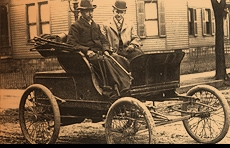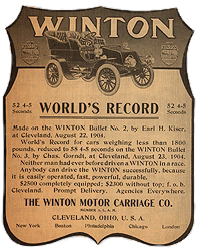Famous But Forgottenreceives Moto Award In Recognition Of Excellence In International Automotive Media 1999 International Automobile Media Awards MOTO Awards IAMA Silver and Bronze Medallions Thomas McKean Memorial Cup |
|
Dear Winton World Wide, I am pleased to announce that the book Famous But Forgotten: The Story Of Alexander Winton, Automotive Pioneer And Industrialist by Thomas F. Saal and Bernard J. Golias has won two awards. The first being a silver medallion given by the IAMC (International Automotive Media Conference) a.k.a "The MOTO Awards," held last November at the Imperial Palace, Las Vegas, NV. The second award was the Thomas McKean Memorial Cup given by the Antique Automobile Club of America. I want to again thank all those who have made the book possible, and will continue in my efforts to enhance any future editions. Sincerely, |
It's a FactIn Cleveland... After Alexander Winton produced his first horseless carriage in 1896, he was followed by many others. By 1930, 75 different nameplates had graced radiators of automobiles made in Cleveland. In 1904 the city was the nation's largest auto producer. Although Cleveland eventually lost the "Motor City" title to Detroit, Cleveland has long been the nation's second largest manufacturer of automotive components.
WantedWinton Automobile, Bicycle and diesel literature, postcards, letters, factory magazines; "The Auto Era," Ephemera, photos, miscellaneous memorabilia.
Bernie Golias |
...continued from home page
On The Road Againby Christopher Jensen endeavoring to demonstrate the entire feasibility of this mode of locomotion." Shanks figured they would travel about 800 miles, including some wandering as they tried to find the best route. "On the route to New York, there will be some pleasing experiences, and again, some ugly difficulties are apt to arise. Of course, if the skies are blue and all men kind, if the roads are free from heavy mud, and, if the water is not too high in some of the streams which must be forded, then the trip will be one of continuous pleasure." Not one to minimize the drama, he also noted other dangers, including heavy rain that would cause "mud galore." In the mountains of New York, he noted, "a big rolling stone which might gather no moss" could swoop down out of the hills and strike the "horseless carriage outfit." About the only misfortune he didn't suggest was being abducted by aliens. Shanks and Winton also carried a letter from the mayor of Cleveland to the mayor of New York. A Cozy AffairThe 1899 Winton is a cozy affair. The wheelbase is an incredibly tiny 69 inches, and the car's overall length is 104 inches. That makes a Toyota Tercel - with a 94-inch wheelbase and an overall length of 162 inches - seem like a stretch limo. It is a two-seater, and a narrow one at that. It will be very easy to rub shoulders. The 1899 Winton came with a top, But it apparently does little more than trap the wind, acting like a backward sail. So we won't use it, substituting foul-weather gear instead. There is no trunk. Likewise, there are no turn signals, no headlights and no brake lights, which is actually not a problem, given the car's leisurely approach to stopping. One could practically send a letter to following cars. Wake and Winton figure our group will cover about 100 miles a day. The newer cars are likely to pass the 1899 and go on ahead because the wooden-framed 1899's top speed is "slow and slower," said Wake. That means about 20 mph on a "nice, flat stretch after you have time to get. .. going," said Holcombe. Wake figures we will need at least eight hours of driving time a day, But the time on the road will probably be much longer, because we have to do routine maintenance. In the beginning, that will include stopping every 20 minutes or so to check the oil levels. The oil goes in three troughs that have tubes dripping oil onto the transmission, engine and differential. |
The gas tank holds three gallons, and Holcombe said the Winton should run happily on 87-octane gas, which is far better than anything it used originally. The gas mileage is uncertain, too. Burn, Baby, BurnThe gasoline drips through a valve onto a plate in the carburetor. The bottom half of the plate is heated by the exhaust, a comforting concept. The gas then evaporates and is sucked into the engine's intake valve. The one-cylinder engine has a 5-by-7-inch bore and stroke. The accelerator is a little button on the floor that uses a pneumatic valve to vary the amount of gas that reaches the intake valve. On corners, the gas can slop off the heating plate, so the Winton temporarily loses power, probably an unplanned safety feature. A crank is used to start the Winton, which has a two-speed transmission. Getting it rolling involves pulling back on one of two long levers. That engages first gear. Once the rear-wheel-drive Winton is moving, that gear is pushed forward, into a neutral position. Then the second lever is pulled to the rear and locked in place. That is high gear. There is no steering wheel. The Winton is steered with a tiller connected directly to the front wheels. It requires full-time attention. "The danger is, if you hit a brick or something in the road it can kick back in your hands,' said Holcombe, who will drive a 1907 Winton. To stop, one takes the high-range gear lever and pushes it forward, disengaging the engine and contracting a band around a drum in the transmission. There is also a foot pedal that operates another band around a drum in the differential. There are no brakes on the wheels, which Wake had to have manufactured, along with the tires. Wake figures it will be more surprising if we do not have a breakdown than if we do. How ever, both he and Holcombe are convinced they can make repairs, and a truck with tools and our be longings will follow the group. The 1899 Winton sold for $1,000 when it was new, Wake said. It was donated to the museum about 20 years ago by James Conant of Fairview Park, and before that was owned by the Rockefeller family. It is insured for $55,000. There is a risk in driving it to New York, but Holcombe sees the trip as part of the museum's educational mission. The route we will follow will be two-lane paved roads, quite a difference from the route Alexander Winton experienced - But Wake figured that would be OK. Winton was 38 when he made the trip with Shanks; Wake is 56. "I'm a little older than Alex. I'm allowed to do it on paved roads," he said. |


